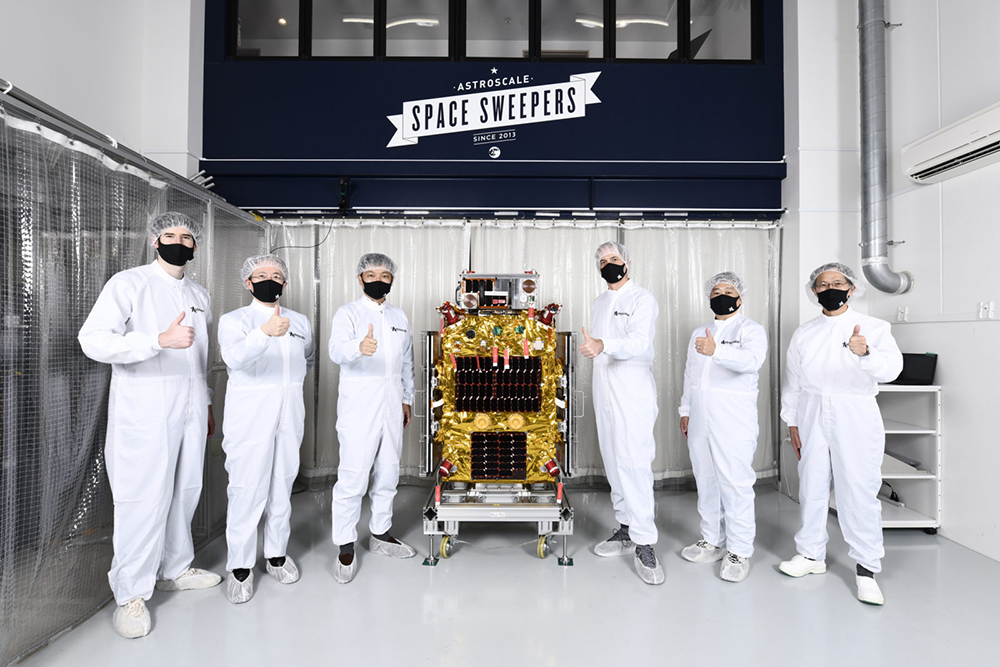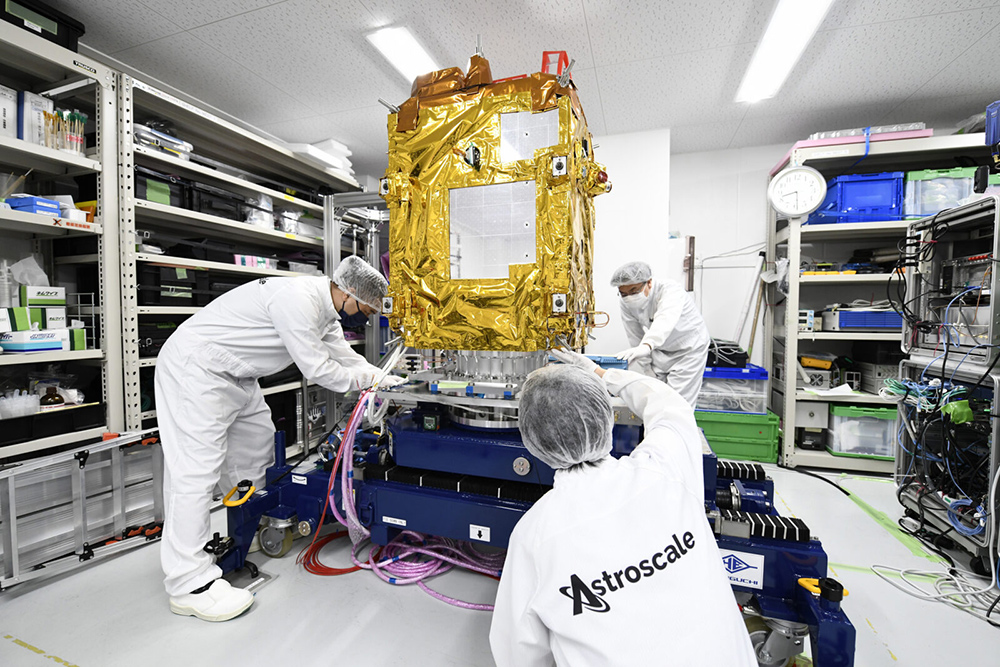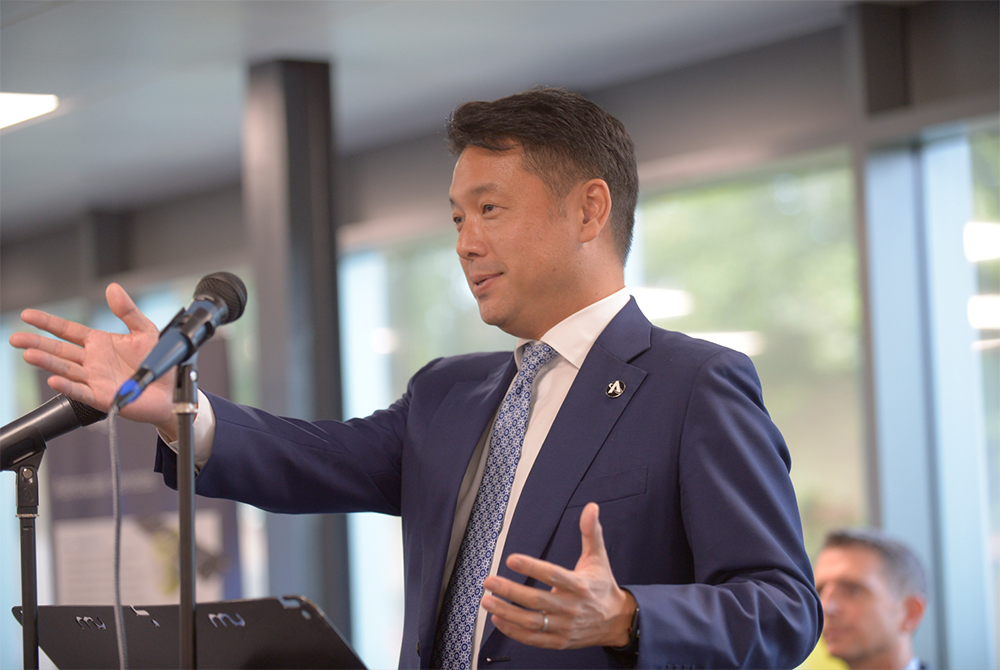 Astroscale的管理層與ELSA-d衛(wèi)星合照,,該衛(wèi)星發(fā)射于2021年。左三為公司創(chuàng)始人兼首席執(zhí)行官岡田光信,。圖片來源:ASTROSCALE
Astroscale的管理層與ELSA-d衛(wèi)星合照,,該衛(wèi)星發(fā)射于2021年。左三為公司創(chuàng)始人兼首席執(zhí)行官岡田光信,。圖片來源:ASTROSCALE岡田光信是日本科技界一位成功的企業(yè)家,,曾創(chuàng)辦一家IT公司,后又作為首席財務官帶領(lǐng)另外一家IT公司上市,。但2013年,,在40歲的不惑之年,他發(fā)現(xiàn)自己陷入了典型的中年危機?!拔铱偸窍?,等我40多歲、50多歲時應該做些什么,?我曾經(jīng)認為自己算得上商業(yè)上的領(lǐng)跑者,,但我的信心突然消失了,”他說,。
岡田在找回激情的過程中想到了自己十幾歲時參加美國宇航局太空營的回憶,,他喜歡極了。他說:“我想,,我也許應該在航天業(yè)重燃激情,。”后來他參加了幾次太空行業(yè)的會議,,2013年4月,,他去德國參會,意識到太空碎片帶來的與日俱增的危險已經(jīng)成為航天業(yè)等待解決的熱門話題,。一周后,,他成立了自己的初創(chuàng)公司Astroscale,自此籌集了3億美元資金,,今年9月和瑞士航天初創(chuàng)公司ClearSpace一起拿到了英國航天局(UKSA)440萬美元的合同,,要設(shè)計一個2025年把兩艘航天器從軌道上移除的任務。
“2013年,,我意識到太空碎片已經(jīng)讓太空環(huán)境變得不可持續(xù),。當時沒有人能提出解決方案?!睂镎f,,“這就是我創(chuàng)辦Astroscale的原因,因為清除太空碎片不僅是商業(yè)機會,,也是保護環(huán)境的必要之舉,。”
太空垃圾的問題大約在13年前進入了公眾視野,。2009年2月10日,,一顆報廢的俄羅斯衛(wèi)星Kosmos 2251與一顆正在運行的美國通信衛(wèi)星Iridium 33相撞,Iridium被摧毀,,這是已知的世界上首次人造衛(wèi)星與太空垃圾的碰撞,。
據(jù)美國宇航局估計,此次撞擊產(chǎn)生了近2000塊碎片,,是所謂的凱斯勒綜合癥的第一個例子,。該理論由美國宇航局天體物理學家唐納德·凱斯勒于1978年提出,,認為到2000年,地球軌道上的碎片密度將足夠高,,以致于衛(wèi)星開始會因為隨機碰撞而解體,,從而產(chǎn)生更多的碎片,撞碎更多的衛(wèi)星,,循環(huán)往復,,“導致碰撞率和碎片數(shù)量呈指數(shù)級增長”。
凱斯勒關(guān)于衛(wèi)星損毀會產(chǎn)生多米諾骨牌連鎖效應的預言還沒有實現(xiàn),,但有令人擔憂的跡象表明,,這一天即將到來。2020年,,衛(wèi)星與碎片之間近距離擦肩而過——即不到一公里的距離——的幾率為每月2000次,,或每天70次。Astroscale的岡田說,,到2021年,,這個數(shù)字增加了兩倍,達到每月6000次,。

“這太可怕了,,”岡田說?!疤瘴矬w的密度已經(jīng)達到了臨界水平?!?/p>
市場研究公司北方天空研究公司(NSR)的太空分析師侯賽因·博哈里表示,,岡田的Astroscale公司是第一家專門針對太空碎片成立的商業(yè)實體。現(xiàn)在,,Astroscale在商業(yè)太空服務行業(yè)面臨大量競爭,,NSR估計,未來10年,,該行業(yè)的收入將達到143億美元,。
從油漆點到公交車
根據(jù)歐洲航天局的數(shù)據(jù),目前約有8850顆衛(wèi)星繞地飛行,,而且這個數(shù)字每天都在增加,。根據(jù)瑞士主營太空垃圾收集的創(chuàng)業(yè)公司ClearSpace的創(chuàng)始人兼首席執(zhí)行官盧克·皮圭的說法,地球每年大約向太空發(fā)射1000顆衛(wèi)星,。2021年,,僅SpaceX公司就發(fā)射了800顆星鏈(Starlink)衛(wèi)星。弗羅斯特沙利文咨詢公司(Frost & Sullivan)的全球太空主管朱莉?霍爾特?瓊斯表示,,目前在軌的衛(wèi)星中,,已經(jīng)有2000多顆不再運轉(zhuǎn),。但最大的問題不在于衛(wèi)星本身,而在于它們周圍的碎片,。
地球軌道上有15000到18000個“大”碎片——大小從10厘米(壘球的直徑)到一輛城市公交車不等,。NSR的博哈里說,還有20萬到23萬件1到10厘米的碎片,。
即使是最小的粒子也會帶來很大的風險,。“即使是油漆斑點大小的小碎片,,在這么高的運轉(zhuǎn)速度下,,也會造成巨大破壞?!被魻柼亍き偹拐f,,“我不知道你看沒看過電影《地心引力》,”她說的是2013年喬治·克魯尼和桑德拉·布洛克主演的電影,,講述的是一架航天飛機被困在凱斯勒綜合癥碎片區(qū)的故事,。“這不是部寫實電影,,但它凸顯了空間碎片潛在的破壞,。”
自從歐空局開始進行追蹤以來,,已經(jīng)記錄了630起“導致碎裂的解體,、爆炸、碰撞或異常事件”,。確定相撞的責任,,或者強迫公司將不再服役的衛(wèi)星移出軌道幾乎是不可能的。太空的管理依照的依然是1967年簽訂的聯(lián)合國條約,?;魻柼亍き偹拐f:“那里有點像狂野西部?!?/p>
“危險在于軌道上的物體和碎片會大量增加,,以至于這些軌道無法再使用?!盇stroscale的首席運營官克里斯?布萊克比表示:“15年后回頭看,,我們會把決定采取措施維護軌道干凈的這一天看成是分水嶺,只有這樣軌道還能為我們的子子孫孫繼續(xù)使用,。如果我們不這么做,,就得為此向后代道歉?!?/p>
磁鐵,,機械臂,,還有魚叉
衛(wèi)星和碎片最終會落回地球。皮圭說,,一顆位于地球上空500公里處的報廢衛(wèi)星——星鏈的衛(wèi)星就是這個高度——將在5年內(nèi)墜落,,而一顆位于600公里處的報廢衛(wèi)星可能需要25年,700公里處的衛(wèi)星則需要一個世紀,。
理論上說,,為了加快這個過程,碎片清理衛(wèi)星可以抓取碎片或報廢衛(wèi)星,,再通過減速并將其拖到較低的高度來降低其軌道,。
但現(xiàn)實中還存在許多復雜的因素。首先,,在近地軌道( 2000公里以下)的物體運行速度非???每秒7-8公里。其次,,殘骸和報廢衛(wèi)星不會主動告知它們的位置,,所以很難找。第三,,許多碎片,,比如火箭助推器,在飛行過程中會旋轉(zhuǎn),。
“軌道上的物體現(xiàn)在還沒有準備好被捕獲,。它們沒有對接接口。它們沒有用來牽引的掛鉤,,”皮圭說,。
為了捕捉不合作的太空獵物,一些初代設(shè)計包括網(wǎng)和魚叉,,就像RemoveDEBRIS項目設(shè)計的那樣,可以成功捕獲它帶入到太空中的小物體,。
但現(xiàn)在擁有340名員工的Astroscale采取了不同的方法,。該公司與OneWeb(僅次于星鏈的全球第二大衛(wèi)星網(wǎng)絡)和Altius Space Machines(一家航空硬件公司)合作,開發(fā)了一種對接板系統(tǒng),,該系統(tǒng)可以讓Astroscale的航天器用磁鐵捕獲OneWeb衛(wèi)星,,再將其拖到大氣層中燒掉。Astroscale公司的ELSA-d宇宙飛船去年已經(jīng)成功發(fā)射并捕獲了一個測試物體,。

展望未來,,Astroscale與日本航天局簽訂了一份合同,將發(fā)射一艘航天器對一節(jié)上面級火箭進行檢查,,為以后拆卸這節(jié)火箭做準備;2024年,,它將發(fā)射ELSA-M航天器,,為OneWeb從軌道上移除一個物體。
ClearSpace則是從瑞士洛桑理工學院的工作中分離出來的,。2009年,,在那里,一組科學家將一顆小型立方體衛(wèi)星(CubeSat,,常被大學用于實驗)發(fā)射到Iridium/Kosmos 碎片區(qū),,并在2012年意識到碎片問題已經(jīng)發(fā)展到必須要解決的地步。

但這支由ClearSpace聯(lián)合創(chuàng)始人穆里爾·理查德領(lǐng)導的團隊對此一開始并沒有什么興趣,。皮圭說,大伙的反應是,,“誰會想要清潔太空? 沒人會為這種東西付錢的,。這背后沒有任何商業(yè)機會?!?當像OneWeb這樣的公司開始獲得發(fā)射數(shù)百顆新衛(wèi)星的融資時,,行業(yè)的商業(yè)前景發(fā)生了變化,ClearSpace 于2018年應運而生,。
ClearSpace已經(jīng)籌集了500萬美元的股權(quán)融資,,擁有80名員工,正在開發(fā)一種四臂機器人航天器,,可以抓取衛(wèi)星和碎片,。 到2025年,作為與歐洲航天局簽署的8600萬歐元(8400萬美元)服務合同的一部分,,ClearSpace將發(fā)射ClearSpace-1來移除一個112公斤的上面級火箭部件,。作為英國宇航局與Astroscale公司簽訂的440萬美元合同的一部分,ClearSpace公司將設(shè)計一項任務,,從軌道上移除兩個在英國注冊的廢棄物體,。

Astroscale還在為以后的任務開發(fā)機器人手臂。
最終,,空間碎片清理公司的目標是提供全方位服務的空間服務公司,,用岡田的話說,就是能夠“回收,、再利用,、修復、補充燃料和清除”空間飛行器的公司,。
“我的目標是,,到2030年,我想讓在軌服務成為常規(guī)工作,,成為太空中維持其可持續(xù)發(fā)展的日常工作,?!彼f,“我們只剩下8年時間了,?!?(財富中文網(wǎng))
譯者:Agatha
岡田光信是日本科技界一位成功的企業(yè)家,曾創(chuàng)辦一家IT公司,,后又作為首席財務官帶領(lǐng)另外一家IT公司上市,。但2013年,在40歲的不惑之年,,他發(fā)現(xiàn)自己陷入了典型的中年危機,。“我總是想,,等我40多歲,、50多歲時應該做些什么?我曾經(jīng)認為自己算得上商業(yè)上的領(lǐng)跑者,,但我的信心突然消失了,,”他說。
岡田在找回激情的過程中想到了自己十幾歲時參加美國宇航局太空營的回憶,,他喜歡極了,。他說:“我想,我也許應該在航天業(yè)重燃激情,?!焙髞硭麉⒓恿藥状翁招袠I(yè)的會議,2013年4月,,他去德國參會,,意識到太空碎片帶來的與日俱增的危險已經(jīng)成為航天業(yè)等待解決的熱門話題。一周后,,他成立了自己的初創(chuàng)公司Astroscale,,自此籌集了3億美元資金,今年9月和瑞士航天初創(chuàng)公司ClearSpace一起拿到了英國航天局(UKSA)440萬美元的合同,,要設(shè)計一個2025年把兩艘航天器從軌道上移除的任務,。
“2013年,我意識到太空碎片已經(jīng)讓太空環(huán)境變得不可持續(xù),。當時沒有人能提出解決方案?!睂镎f,,“這就是我創(chuàng)辦Astroscale的原因,因為清除太空碎片不僅是商業(yè)機會,,也是保護環(huán)境的必要之舉,?!?/p>
太空垃圾的問題大約在13年前進入了公眾視野。2009年2月10日,,一顆報廢的俄羅斯衛(wèi)星Kosmos 2251與一顆正在運行的美國通信衛(wèi)星Iridium 33相撞,,Iridium被摧毀,這是已知的世界上首次人造衛(wèi)星與太空垃圾的碰撞,。
據(jù)美國宇航局估計,,此次撞擊產(chǎn)生了近2000塊碎片,是所謂的凱斯勒綜合癥的第一個例子,。該理論由美國宇航局天體物理學家唐納德·凱斯勒于1978年提出,,認為到2000年,地球軌道上的碎片密度將足夠高,,以致于衛(wèi)星開始會因為隨機碰撞而解體,,從而產(chǎn)生更多的碎片,撞碎更多的衛(wèi)星,,循環(huán)往復,,“導致碰撞率和碎片數(shù)量呈指數(shù)級增長”。
凱斯勒關(guān)于衛(wèi)星損毀會產(chǎn)生多米諾骨牌連鎖效應的預言還沒有實現(xiàn),,但有令人擔憂的跡象表明,,這一天即將到來。2020年,,衛(wèi)星與碎片之間近距離擦肩而過——即不到一公里的距離——的幾率為每月2000次,,或每天70次。Astroscale的岡田說,,到2021年,,這個數(shù)字增加了兩倍,達到每月6000次,。
“這太可怕了,,”岡田說?!疤瘴矬w的密度已經(jīng)達到了臨界水平,。”
市場研究公司北方天空研究公司(NSR)的太空分析師侯賽因·博哈里表示,,岡田的Astroscale公司是第一家專門針對太空碎片成立的商業(yè)實體?,F(xiàn)在,Astroscale在商業(yè)太空服務行業(yè)面臨大量競爭,,NSR估計,,未來10年,該行業(yè)的收入將達到143億美元。
從油漆點到公交車
根據(jù)歐洲航天局的數(shù)據(jù),,目前約有8850顆衛(wèi)星繞地飛行,,而且這個數(shù)字每天都在增加。根據(jù)瑞士主營太空垃圾收集的創(chuàng)業(yè)公司ClearSpace的創(chuàng)始人兼首席執(zhí)行官盧克·皮圭的說法,,地球每年大約向太空發(fā)射1000顆衛(wèi)星,。2021年,僅SpaceX公司就發(fā)射了800顆星鏈(Starlink)衛(wèi)星,。弗羅斯特沙利文咨詢公司(Frost & Sullivan)的全球太空主管朱莉?霍爾特?瓊斯表示,,目前在軌的衛(wèi)星中,已經(jīng)有2000多顆不再運轉(zhuǎn),。但最大的問題不在于衛(wèi)星本身,,而在于它們周圍的碎片。
地球軌道上有15000到18000個“大”碎片——大小從10厘米(壘球的直徑)到一輛城市公交車不等,。NSR的博哈里說,,還有20萬到23萬件1到10厘米的碎片。
即使是最小的粒子也會帶來很大的風險,?!凹词故怯推岚唿c大小的小碎片,在這么高的運轉(zhuǎn)速度下,,也會造成巨大破壞,。”霍爾特·瓊斯說,,“我不知道你看沒看過電影《地心引力》,,”她說的是2013年喬治·克魯尼和桑德拉·布洛克主演的電影,講述的是一架航天飛機被困在凱斯勒綜合癥碎片區(qū)的故事,?!斑@不是部寫實電影,但它凸顯了空間碎片潛在的破壞,?!?/p>
自從歐空局開始進行追蹤以來,已經(jīng)記錄了630起“導致碎裂的解體,、爆炸,、碰撞或異常事件”。確定相撞的責任,,或者強迫公司將不再服役的衛(wèi)星移出軌道幾乎是不可能的,。太空的管理依照的依然是1967年簽訂的聯(lián)合國條約?;魻柼亍き偹拐f:“那里有點像狂野西部,?!?/p>
“危險在于軌道上的物體和碎片會大量增加,以至于這些軌道無法再使用,。”Astroscale的首席運營官克里斯?布萊克比表示:“15年后回頭看,,我們會把決定采取措施維護軌道干凈的這一天看成是分水嶺,,只有這樣軌道還能為我們的子子孫孫繼續(xù)使用。如果我們不這么做,,就得為此向后代道歉,。”
磁鐵,,機械臂,,還有魚叉
衛(wèi)星和碎片最終會落回地球。皮圭說,,一顆位于地球上空500公里處的報廢衛(wèi)星——星鏈的衛(wèi)星就是這個高度——將在5年內(nèi)墜落,,而一顆位于600公里處的報廢衛(wèi)星可能需要25年,700公里處的衛(wèi)星則需要一個世紀,。
理論上說,,為了加快這個過程,碎片清理衛(wèi)星可以抓取碎片或報廢衛(wèi)星,,再通過減速并將其拖到較低的高度來降低其軌道,。
但現(xiàn)實中還存在許多復雜的因素。首先,,在近地軌道( 2000公里以下)的物體運行速度非???每秒7-8公里。其次,,殘骸和報廢衛(wèi)星不會主動告知它們的位置,,所以很難找。第三,,許多碎片,,比如火箭助推器,在飛行過程中會旋轉(zhuǎn),。
“軌道上的物體現(xiàn)在還沒有準備好被捕獲,。它們沒有對接接口。它們沒有用來牽引的掛鉤,,”皮圭說,。
為了捕捉不合作的太空獵物,一些初代設(shè)計包括網(wǎng)和魚叉,,就像RemoveDEBRIS項目設(shè)計的那樣,,可以成功捕獲它帶入到太空中的小物體,。
但現(xiàn)在擁有340名員工的Astroscale采取了不同的方法。該公司與OneWeb(僅次于星鏈的全球第二大衛(wèi)星網(wǎng)絡)和Altius Space Machines(一家航空硬件公司)合作,,開發(fā)了一種對接板系統(tǒng),,該系統(tǒng)可以讓Astroscale的航天器用磁鐵捕獲OneWeb衛(wèi)星,再將其拖到大氣層中燒掉,。Astroscale公司的ELSA-d宇宙飛船去年已經(jīng)成功發(fā)射并捕獲了一個測試物體,。
展望未來,Astroscale與日本航天局簽訂了一份合同,,將發(fā)射一艘航天器對一節(jié)上面級火箭進行檢查,,為以后拆卸這節(jié)火箭做準備;2024年,它將發(fā)射ELSA-M航天器,,為OneWeb從軌道上移除一個物體,。
ClearSpace則是從瑞士洛桑理工學院的工作中分離出來的。2009年,,在那里,,一組科學家將一顆小型立方體衛(wèi)星(CubeSat,常被大學用于實驗)發(fā)射到Iridium/Kosmos 碎片區(qū),,并在2012年意識到碎片問題已經(jīng)發(fā)展到必須要解決的地步,。
但這支由ClearSpace聯(lián)合創(chuàng)始人穆里爾·理查德領(lǐng)導的團隊對此一開始并沒有什么興趣。皮圭說,,大伙的反應是,,“誰會想要清潔太空? 沒人會為這種東西付錢的。這背后沒有任何商業(yè)機會,?!?當像OneWeb這樣的公司開始獲得發(fā)射數(shù)百顆新衛(wèi)星的融資時,行業(yè)的商業(yè)前景發(fā)生了變化,,ClearSpace 于2018年應運而生,。
ClearSpace已經(jīng)籌集了500萬美元的股權(quán)融資,擁有80名員工,,正在開發(fā)一種四臂機器人航天器,,可以抓取衛(wèi)星和碎片。 到2025年,,作為與歐洲航天局簽署的8600萬歐元(8400萬美元)服務合同的一部分,,ClearSpace將發(fā)射ClearSpace-1來移除一個112公斤的上面級火箭部件。作為英國宇航局與Astroscale公司簽訂的440萬美元合同的一部分,,ClearSpace公司將設(shè)計一項任務,,從軌道上移除兩個在英國注冊的廢棄物體。
Astroscale還在為以后的任務開發(fā)機器人手臂,。
最終,,空間碎片清理公司的目標是提供全方位服務的空間服務公司,,用岡田的話說,就是能夠“回收,、再利用,、修復、補充燃料和清除”空間飛行器的公司,。
“我的目標是,,到2030年,我想讓在軌服務成為常規(guī)工作,,成為太空中維持其可持續(xù)發(fā)展的日常工作?!彼f,,“我們只剩下8年時間了?!?(財富中文網(wǎng))
譯者:Agatha
Nobu Okada was a successful tech entrepreneur in Japan—the founder of one IT company and the CFO who led another to its IPO. But when he turned 40 in 2013, he found himself in a classic midlife crisis. “I was wondering, What should I do during my forties or fifties? I had felt like I was a kind of front-runner in business, but all of a sudden I lost confidence,” he says.
Looking to rekindle his passion, Okada recalled how he loved attending a NASA Space Camp in the U.S. as a teenager. “I thought it might be the space industry where I should ignite my passion again,” he says. He went to several space conferences and, while attending one in Germany in April 2013, discovered that the growing danger of space debris was the industry’s hot unsolved topic. A week later, he set up his startup Astroscale, which has since raised $300 million in funding and in September won a $4.4 million contract with the U.K. Space Agency (UKSA) alongside Swiss space startup ClearSpace to design a mission to remove two spacecraft from orbit in 2025.
“I realized in 2013 that space debris had already made the space environment unsustainable. And no one had a solution for the problem,” Okada says. “That’s why I started Astroscale, because removing space debris was not only a business opportunity, but also an environmental necessity.”
The problem of space junk entered public consciousness about 13 years ago. On Feb. 10, 2009, a defunct Russian satellite, the Kosmos 2251, collided with a working American communications satellite, the Iridium 33, destroying the Iridium and marking the world’s first recorded collision between a man-made satellite and a piece of space junk.
That crash produced almost 2,000 pieces of debris, according to NASA estimates, and was the first example of the so-called Kessler Syndrome. The theory, proposed in 1978 by NASA astrophysicist Donald Kessler, held that by 2000 debris in Earth’s orbit would be so dense that satellites would begin breaking up due to random collisions, creating more debris to break up more objects, and so on, “resulting in an exponential growth in the collision rate and debris population.”
Kessler’s theory of a cascading domino effect of satellite destruction hasn’t yet come to pass, but there are worrying signs that the day is approaching. In 2020, near misses between satellites and debris—that is, less than a kilometer of distance—occurred 2,000 times per month, or 70 times per day. They tripled in 2021, to 6,000 per month, says Astroscale’s Okada.
“It’s horrifying,” Okada says. “The density of objects in space has reached a critical level.”
Okada’s Astroscale was the first commercial entity founded to target space debris, says Hussain Bokhari, a space analyst at the market research firm Northern Sky Research (NSR). Now Astroscale has plenty of competition in the commercial space services industry that NSR estimates will earn $14.3 billion in revenue over the next decade.
From a fleck of paint to a city bus
About 8,850 satellites orbit earth today, according to the ESA, and that total is climbing on a daily basis. Earth is sending about 1,000 satellites into space every year, according to Luc Piguet, cofounder and CEO of ClearSpace, a Swiss startup that collects space junk. In 2021, SpaceX alone launched 800 Starlink satellites. Of the satellites currently in orbit, more than 2,000 no longer function, says Julie Holt Jones, the global lead for space at the consultancy Frost & Sullivan. But the problem isn’t the satellites as much as the debris around them.
The earth’s orbit contains 15,000 to 18,000 pieces of “big” debris—or objects that range from 10 centimeters, the diameter of a softball, to the size of a city bus. There are another 200,000 to 230,000 pieces between 1 and 10 centimeters, says NSR’s Bokhari.
Even the smallest particles pose a big risk. “You can have tiny fragments, the size of a fleck of a piece of paint, and they’re going at such high speed they can cause tremendous damage,” says Holt Jones. “I don’t know if you’ve ever seen the film Gravity,” she adds, referring to the 2013 George Clooney–Sandra Bullock film about a space shuttle caught by a Kessler Syndrome debris field. “It’s not realistic in all aspects, but it highlights the potential devastating effect of space debris.”
Since the ESA started keeping track, it has recorded 630 “break-ups, explosions, collisions, or anomalous events resulting in fragmentation.” Assigning responsibility for the collisions—or forcing companies to remove expiring satellites from orbit—is almost impossible. Space is still governed by a UN treaty from 1967. “It’s a bit like the Wild West up there,” says Holt Jones.
“The danger is a proliferation of objects and debris in orbit to the point where those orbits become unusable,” says Chris Blackerby, Astroscale’s COO. “We’re going to look back on this in 15 years and see this as a watershed moment where we’re taking the steps to make sure that these orbits are clean and remain usable for our children and their children. Or if we don’t, we’re going to be apologizing to future generations for messing it up.”
Magnets, robot arms, and harpoons
Satellites and debris fall back to Earth—eventually. A dead satellite at about 500 kilometers above earth—where Starlink’s satellites are—will fall in five years, says Piguet, while one at 600 kilometers might take 25 years and one at 700 kilometers a century.
To speed up the process, the theory goes, a debris-clearing satellite could grab a piece of debris or a dead satellite and degrade its orbit by slowing it down and dragging it to a lower altitude.
But there are many complicating factors. First, objects in low Earth orbit (LEO, under 2,000 kilometers) travel super fast: 7–8 kilometers a second. Second, debris and dead satellites don’t communicate their positions, which makes them hard to find. Third, many pieces of debris, like rocket boosters, rotate as they travel.
“The objects in orbit now are not prepared to be captured. They don’t have a docking interface on them. They don’t have a hook for towing,” says Piguet.
Early designs for capturing uncooperative space prey included nets and harpoons like those designed by the RemoveDEBRIS project, which successfully caught small objects it took into space.
But Astroscale, which now has 340 employees, took a different approach. Working with OneWeb, the world’s second biggest satellite network after Starlink, and Altius Space Machines, an aerospace hardware company, the firm developed a docking plate system that would allow Astroscale spacecraft to capture OneWeb satellites with a magnet and drag them down to burn up in the atmosphere. Astroscale’s ELSA-d spacecraft already successfully released and captured a test object last year.
Going forward, Astroscale has a contract with the Japanese space agency to launch a spacecraft to inspect an upper stage rocket in preparation for removing it later on; in 2024 it will launch its ELSA-M spacecraft to remove one object from orbit for OneWeb.
ClearSpace, for its part, spun out of work at EPFL, the Swiss Institute of Technology of Lausanne. There, a team of scientists sent a tiny CubeSat satellite (often used by universities for experiments) into the Iridium/Kosmos debris field in 2009 and realized, in 2012, the debris problem had grown enough that it needed to be addressed.
But the team, led by ClearSpace cofounder Muriel Richard, found little interest at first. The reaction was, “Who would ever want to clean space? Nobody will ever pay for something like this. There’s no business case behind it,” Piguet says. That outlook changed when companies like OneWeb began receiving funding to send up hundreds of new satellites, and ClearSpace launched in 2018.
ClearSpace, which has raised $5 million in equity funding and employs 80 people, is developing a four-armed robot spacecraft that will grab satellites and debris. In 2025, as part of an €86 million ($84 million) service contract it signed with the European Space Agency (ESA), ClearSpace is set to launch ClearSpace-1 to remove a 112-kilogram upper-stage rocket part. And as part of the $4.4 million UKSA contract it shares with Astroscale, ClearSpace will design a mission to remove two U.K.-registered derelict objects from orbit.
Astroscale is also developing a robot arm for later missions.
In the end, the goal for space debris removal companies is to become full services space service firms that, in Okada’s words, can “recycle, reuse, repair, refuel, and remove” space objects.
“My goal is, by 2030, I want to make in-orbit servicing just routine work, a daily job in space to make it sustainable,” he says. “We just have only eight years to go.”






